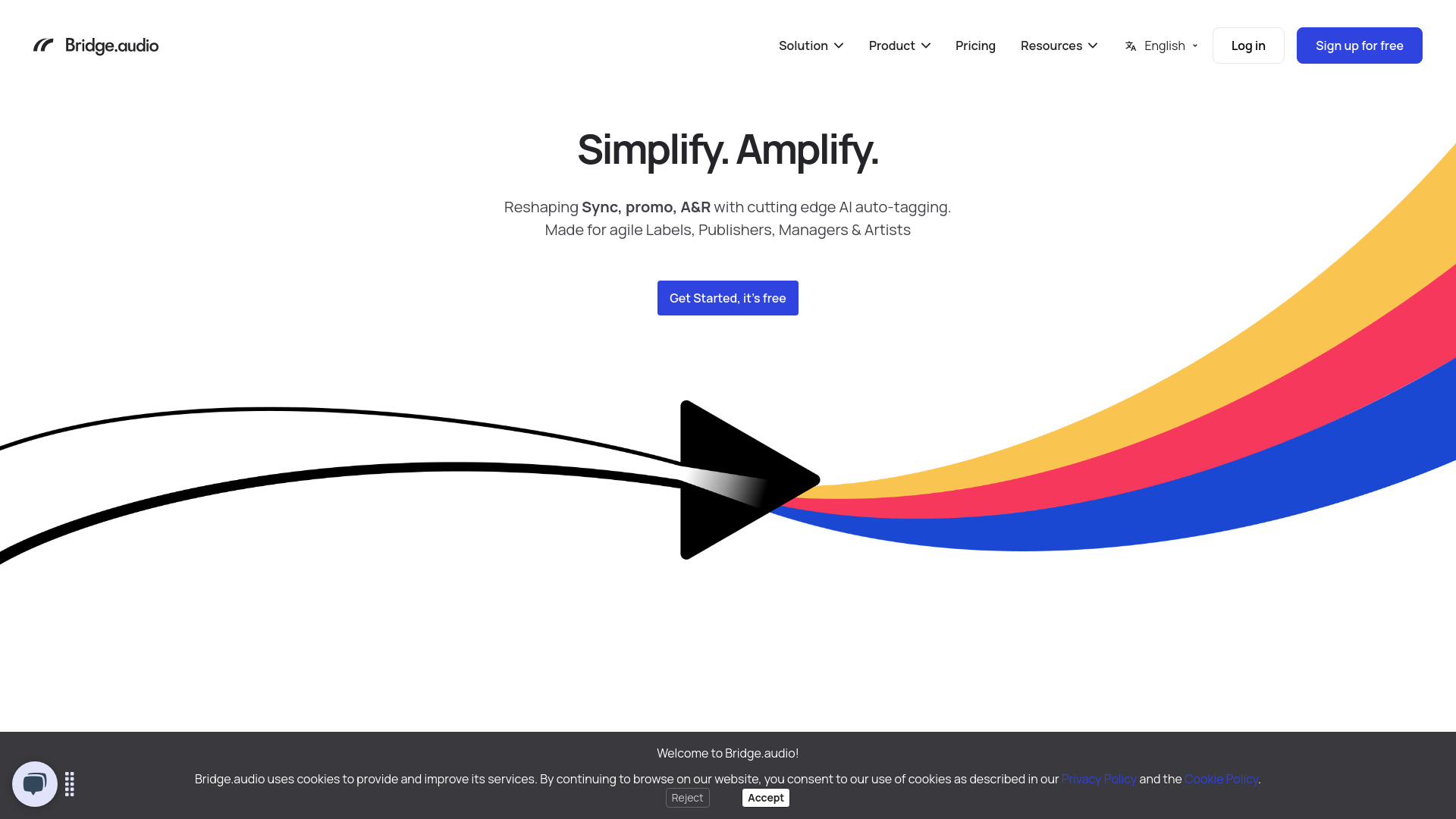- Home
- AI Marketing
- Bridge audio

Bridge audio
Open Website-
Tool Introduction:AI-tagged music sharing for pros, linking rights to sync buyers.
-
Inclusion Date:Nov 06, 2025
-
Social Media & Email:
Tool Information
What is Bridge audio AI
Bridge audio AI is a file-sharing and music catalog platform built for labels, publishers, artists, and music libraries to connect directly with buyers in the audiovisual industry. It combines secure audio management with AI-powered autotagging to enhance metadata quality and improve discoverability. Users organize tracks into collaborative workspaces, share branded streaming links, and pitch to marketplaces for sync opportunities. By unifying delivery, review, and rights workflows, it helps teams move from upload to license with less friction and better search accuracy.
Main Features of Bridge audio AI
- AI autotagging: Automatically enriches tracks with genre, mood, instrumentation, and tempo tags to boost search relevance.
- Secure sharing & streaming: Watermarked, expiring, or password-protected links with high-quality audio previews.
- Catalog & metadata management: Centralized track library with custom fields, bulk edits, and version control.
- Collaborative workspaces: Roles, permissions, comments, and approvals to streamline team workflows.
- Playlists & pitch decks: Curate collections with notes, artwork, and context for music supervisors and clients.
- Marketplace & sync focus: Tools to surface catalogs to buyers across film, TV, ads, and games.
- Rights & clearance: Attach ownership, split info, and usage terms to simplify clearance conversations.
- Analytics: Track opens, plays, downloads, and engagement to guide A&R and pitching decisions.
- Branding options: Custom domains, logos, and player styling for professional presentations.
- Advanced search: Filter by tags, mood, BPM, key, and other metadata to find the right cue fast.
Who Can Use Bridge audio AI
Bridge audio AI suits labels, publishers, production music companies, indie artists, composers, and sync agents managing catalogs and pitches. It also supports A&R teams evaluating submissions, marketing teams running promo campaigns, and music supervisors, editors, and post houses who need fast, accurate search and secure previewing. Agencies and content creators benefit from organized playlists and clear rights information during pitching and licensing.
How to Use Bridge audio AI
- Create an account and set up a workspace for your catalog or team.
- Upload tracks in preferred formats and import or edit metadata (title, writers, splits).
- Run AI autotagging to generate genre, mood, and instrumentation tags, then refine as needed.
- Organize songs into playlists or collections for projects, campaigns, or pitching.
- Configure permissions and share secure, branded links with buyers or collaborators.
- Pitch to the marketplace or specific supervisors; include notes and usage terms.
- Monitor analytics on opens, listens, and downloads to prioritize follow-ups.
- Update rights info, versions, and notes as deals progress and feedback arrives.
Bridge audio AI Use Cases
Music libraries use it to pitch cues for film trailers and TV promos with accurate mood tags. Labels centralize masters and instrumentals for ad agencies and sync partners. Publishers streamline clearance by attaching splits and contact details. A&R teams review submissions with engagement analytics. Indie artists build press kits and send watermarked links to supervisors. Post-production teams search by tempo, key, and emotion to quickly find on-brief tracks.
Pros and Cons of Bridge audio AI
Pros:
- AI-driven tagging improves discoverability and search accuracy.
- Secure, branded sharing enhances professionalism and control.
- End-to-end workflow for catalog, pitching, and clearance.
- Analytics inform A&R and pitching strategy.
- Collaborative workspaces reduce back-and-forth and version confusion.
Cons:
- Results depend on well-maintained metadata and tag validation.
- Learning curve for teams migrating large catalogs and workflows.
- Storage and advanced features may require higher-tier plans.
- Requires reliable internet for large uploads and streaming review.
FAQs about Bridge audio AI
Does Bridge audio AI support high-quality audio?
Yes. It supports high-quality streaming previews and upload of professional formats suitable for review workflows.
Can I customize sharing links?
You can create branded, secure links with optional passwords, expirations, and watermarking settings.
How accurate is the AI autotagging?
Autotagging provides a strong starting point for genre, mood, and instrumentation; users can review and refine tags for precision.
Is it suitable for sync licensing?
Yes. It includes features tailored to sync, such as detailed rights info, playlists for briefs, and marketplace exposure.
Can teams collaborate in one account?
Workspaces support roles, permissions, comments, and shared playlists to coordinate across A&R, marketing, and licensing.




